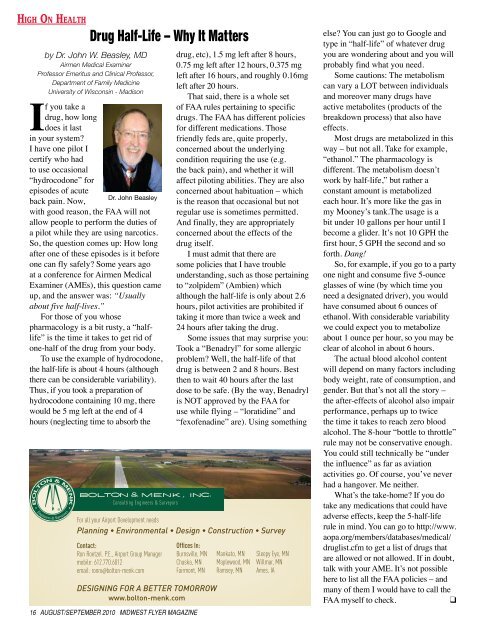AGAZINE - Midwest Flyer
AGAZINE - Midwest Flyer
AGAZINE - Midwest Flyer
Create successful ePaper yourself
Turn your PDF publications into a flip-book with our unique Google optimized e-Paper software.
Hi g h On He a l t h<br />
Drug Half-Life – Why It Matters<br />
by Dr. John W. Beasley, MD<br />
Airmen Medical Examiner<br />
Professor Emeritus and Clinical Professor,<br />
Department of Family Medicine<br />
University of Wisconsin - Madison<br />
If you take a<br />
drug, how long<br />
does it last<br />
in your system?<br />
I have one pilot I<br />
certify who had<br />
to use occasional<br />
“hydrocodone” for<br />
episodes of acute<br />
Dr. John Beasley<br />
back pain. Now,<br />
with good reason, the FAA will not<br />
allow people to perform the duties of<br />
a pilot while they are using narcotics.<br />
So, the question comes up: How long<br />
after one of these episodes is it before<br />
one can fly safely? Some years ago<br />
at a conference for Airmen Medical<br />
Examiner (AMEs), this question came<br />
up, and the answer was: “Usually<br />
about five half-lives.”<br />
For those of you whose<br />
pharmacology is a bit rusty, a “halflife”<br />
is the time it takes to get rid of<br />
one-half of the drug from your body.<br />
To use the example of hydrocodone,<br />
the half-life is about 4 hours (although<br />
there can be considerable variability).<br />
Thus, if you took a preparation of<br />
hydrocodone containing 10 mg, there<br />
would be 5 mg left at the end of 4<br />
hours (neglecting time to absorb the<br />
Consulting Engineers & Surveyors<br />
16 AUGUST/SEPTEMBER 2010 MIDWEST FLYER M<strong>AGAZINE</strong><br />
drug, etc), 1.5 mg left after 8 hours,<br />
0.75 mg left after 12 hours, 0.375 mg<br />
left after 16 hours, and roughly 0.16mg<br />
left after 20 hours.<br />
That said, there is a whole set<br />
of FAA rules pertaining to specific<br />
drugs. The FAA has different policies<br />
for different medications. Those<br />
friendly feds are, quite properly,<br />
concerned about the underlying<br />
condition requiring the use (e.g.<br />
the back pain), and whether it will<br />
affect piloting abilities. They are also<br />
concerned about habituation – which<br />
is the reason that occasional but not<br />
regular use is sometimes permitted.<br />
And finally, they are appropriately<br />
concerned about the effects of the<br />
drug itself.<br />
I must admit that there are<br />
some policies that I have trouble<br />
understanding, such as those pertaining<br />
to “zolpidem” (Ambien) which<br />
although the half-life is only about 2.6<br />
hours, pilot activities are prohibited if<br />
taking it more than twice a week and<br />
24 hours after taking the drug.<br />
Some issues that may surprise you:<br />
Took a “Benadryl” for some allergic<br />
problem? Well, the half-life of that<br />
drug is between 2 and 8 hours. Best<br />
then to wait 40 hours after the last<br />
dose to be safe. (By the way, Benadryl<br />
is NOT approved by the FAA for<br />
use while flying – “loratidine” and<br />
“fexofenadine” are). Using something<br />
For all your Airport Development needs<br />
Planning ¤ Environmental ¤ Design ¤ Construction ¤ Survey<br />
Contact:<br />
Ron Roetzel. P.E., Airport Group Manager<br />
mobile: 612.770.6012<br />
email: ronro@bolton-menk.com<br />
Offices In:<br />
Burnsville, MN<br />
Chaska, MN<br />
Fairmont, MN<br />
DESIGNING FOR A BETTER TOMORROW<br />
www.bolton-menk.com<br />
Mankato, MN<br />
Maplewood, MN<br />
Ramsey, MN<br />
Sleepy Eye, MN<br />
Willmar, MN<br />
Ames, IA<br />
else? You can just go to Google and<br />
type in “half-life” of whatever drug<br />
you are wondering about and you will<br />
probably find what you need.<br />
Some cautions: The metabolism<br />
can vary a LOT between individuals<br />
and moreover many drugs have<br />
active metabolites (products of the<br />
breakdown process) that also have<br />
effects.<br />
Most drugs are metabolized in this<br />
way – but not all. Take for example,<br />
“ethanol.” The pharmacology is<br />
different. The metabolism doesn’t<br />
work by half-life,” but rather a<br />
constant amount is metabolized<br />
each hour. It’s more like the gas in<br />
my Mooney’s tank.The usage is a<br />
bit under 10 gallons per hour until I<br />
become a glider. It’s not 10 GPH the<br />
first hour, 5 GPH the second and so<br />
forth. Dang!<br />
So, for example, if you go to a party<br />
one night and consume five 5-ounce<br />
glasses of wine (by which time you<br />
need a designated driver), you would<br />
have consumed about 6 ounces of<br />
ethanol. With considerable variability<br />
we could expect you to metabolize<br />
about 1 ounce per hour, so you may be<br />
clear of alcohol in about 6 hours.<br />
The actual blood alcohol content<br />
will depend on many factors including<br />
body weight, rate of consumption, and<br />
gender. But that’s not all the story –<br />
the after-effects of alcohol also impair<br />
performance, perhaps up to twice<br />
the time it takes to reach zero blood<br />
alcohol. The 8-hour “bottle to throttle”<br />
rule may not be conservative enough.<br />
You could still technically be “under<br />
the influence” as far as aviation<br />
activities go. Of course, you’ve never<br />
had a hangover. Me neither.<br />
What’s the take-home? If you do<br />
take any medications that could have<br />
adverse effects, keep the 5-half-life<br />
rule in mind. You can go to http://www.<br />
aopa.org/members/databases/medical/<br />
druglist.cfm to get a list of drugs that<br />
are allowed or not allowed. If in doubt,<br />
talk with your AME. It’s not possible<br />
here to list all the FAA policies – and<br />
many of them I would have to call the<br />
FAA myself to check.<br />
q
















